Case Study Analysis: Strategies for Workplace Safety Management
VerifiedAdded on 2020/03/15
|10
|2308
|203
Case Study
AI Summary
This case study examines workplace safety, emphasizing the organization's responsibility to protect employees from hazards. It identifies various safety and workplace hazards, including chemical, physical, ergonomic, and work organization hazards. The study outlines strategies to prevent safety breaches, such as communication, risk visibility, data analysis, and workforce input. The analysis highlights the importance of hazard assessment, safety protocols, and integrating safety into operational risk management. Recommendations include comprehensive health and safety assessments, data integration, and aligning safety with business goals. The case study stresses the need for proactive measures to avoid injuries, illnesses, and fatalities, promoting a culture of safety within organizations.
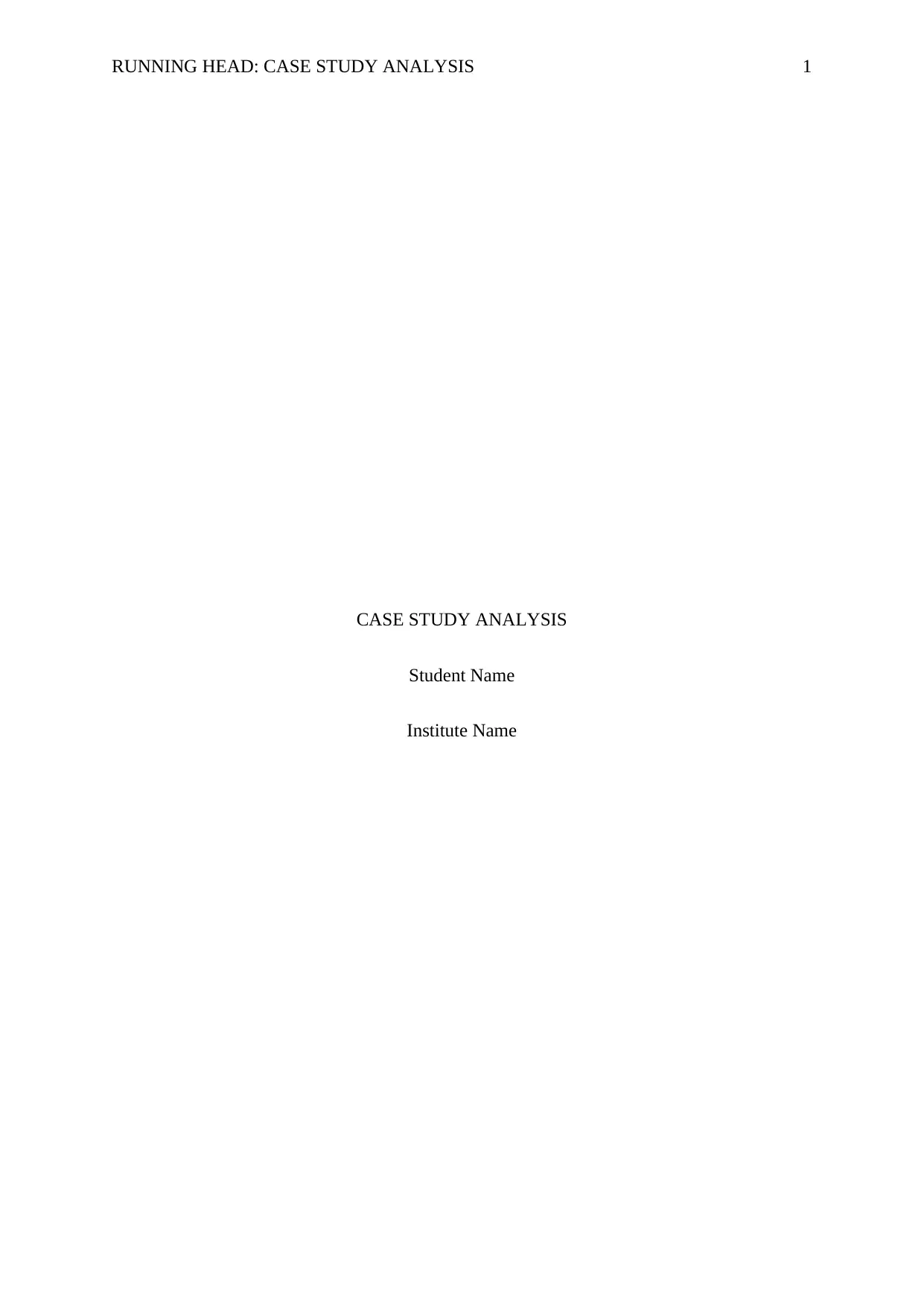
RUNNING HEAD: CASE STUDY ANALYSIS 1
CASE STUDY ANALYSIS
Student Name
Institute Name
CASE STUDY ANALYSIS
Student Name
Institute Name
Paraphrase This Document
Need a fresh take? Get an instant paraphrase of this document with our AI Paraphraser
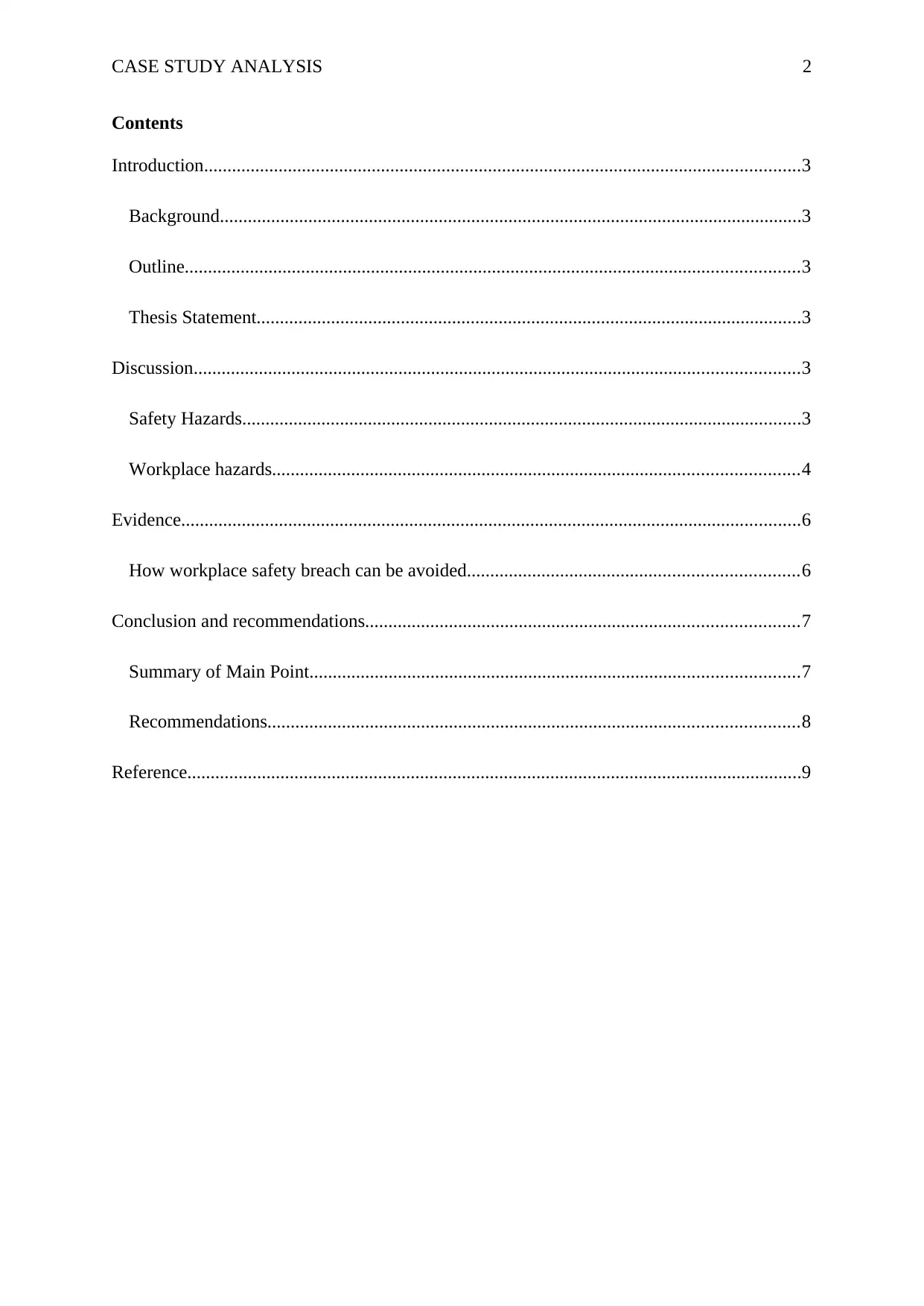
CASE STUDY ANALYSIS 2
Contents
Introduction................................................................................................................................3
Background.............................................................................................................................3
Outline....................................................................................................................................3
Thesis Statement.....................................................................................................................3
Discussion..................................................................................................................................3
Safety Hazards........................................................................................................................3
Workplace hazards.................................................................................................................4
Evidence.....................................................................................................................................6
How workplace safety breach can be avoided.......................................................................6
Conclusion and recommendations.............................................................................................7
Summary of Main Point.........................................................................................................7
Recommendations..................................................................................................................8
Reference....................................................................................................................................9
Contents
Introduction................................................................................................................................3
Background.............................................................................................................................3
Outline....................................................................................................................................3
Thesis Statement.....................................................................................................................3
Discussion..................................................................................................................................3
Safety Hazards........................................................................................................................3
Workplace hazards.................................................................................................................4
Evidence.....................................................................................................................................6
How workplace safety breach can be avoided.......................................................................6
Conclusion and recommendations.............................................................................................7
Summary of Main Point.........................................................................................................7
Recommendations..................................................................................................................8
Reference....................................................................................................................................9
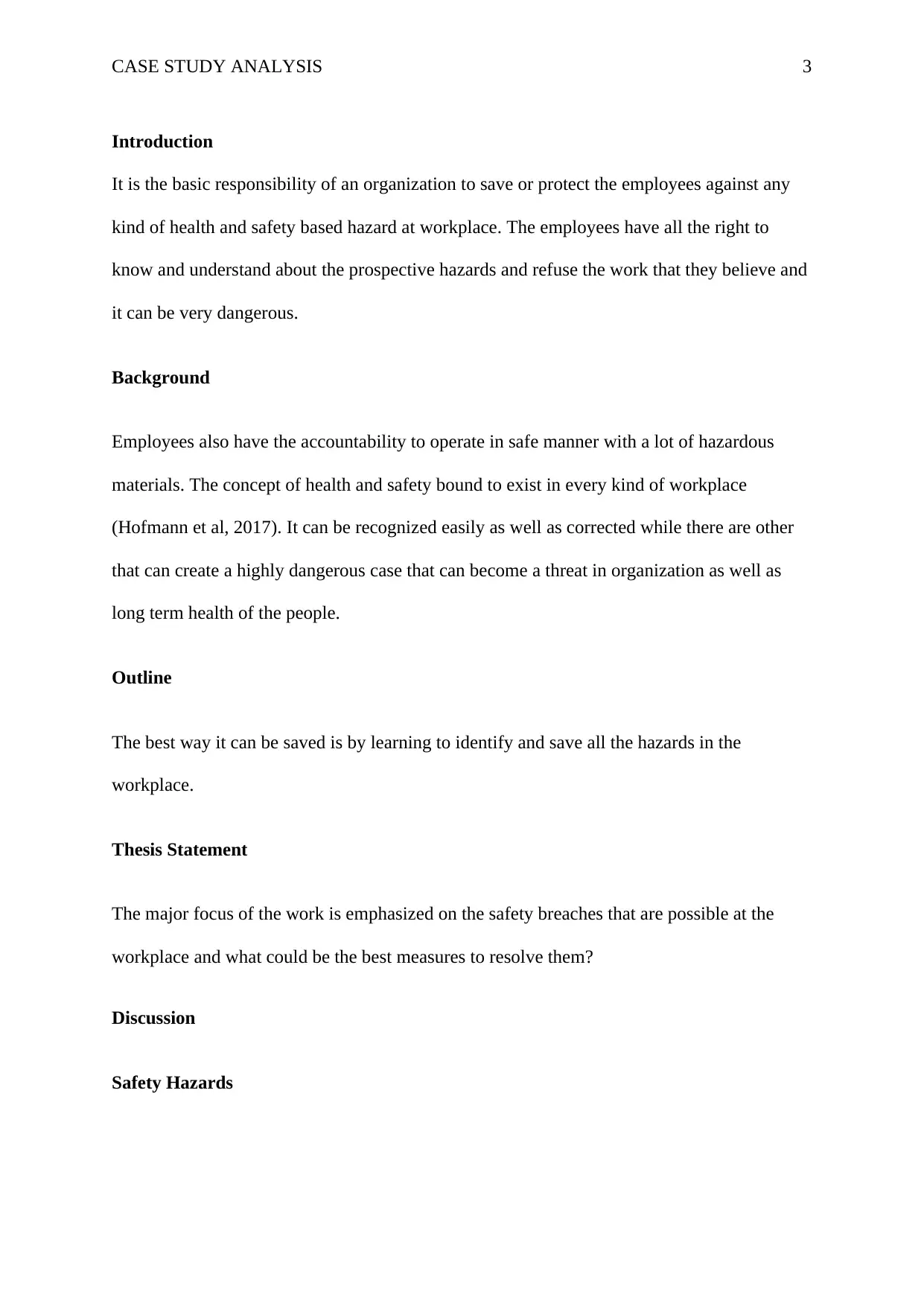
CASE STUDY ANALYSIS 3
Introduction
It is the basic responsibility of an organization to save or protect the employees against any
kind of health and safety based hazard at workplace. The employees have all the right to
know and understand about the prospective hazards and refuse the work that they believe and
it can be very dangerous.
Background
Employees also have the accountability to operate in safe manner with a lot of hazardous
materials. The concept of health and safety bound to exist in every kind of workplace
(Hofmann et al, 2017). It can be recognized easily as well as corrected while there are other
that can create a highly dangerous case that can become a threat in organization as well as
long term health of the people.
Outline
The best way it can be saved is by learning to identify and save all the hazards in the
workplace.
Thesis Statement
The major focus of the work is emphasized on the safety breaches that are possible at the
workplace and what could be the best measures to resolve them?
Discussion
Safety Hazards
Introduction
It is the basic responsibility of an organization to save or protect the employees against any
kind of health and safety based hazard at workplace. The employees have all the right to
know and understand about the prospective hazards and refuse the work that they believe and
it can be very dangerous.
Background
Employees also have the accountability to operate in safe manner with a lot of hazardous
materials. The concept of health and safety bound to exist in every kind of workplace
(Hofmann et al, 2017). It can be recognized easily as well as corrected while there are other
that can create a highly dangerous case that can become a threat in organization as well as
long term health of the people.
Outline
The best way it can be saved is by learning to identify and save all the hazards in the
workplace.
Thesis Statement
The major focus of the work is emphasized on the safety breaches that are possible at the
workplace and what could be the best measures to resolve them?
Discussion
Safety Hazards
⊘ This is a preview!⊘
Do you want full access?
Subscribe today to unlock all pages.

Trusted by 1+ million students worldwide
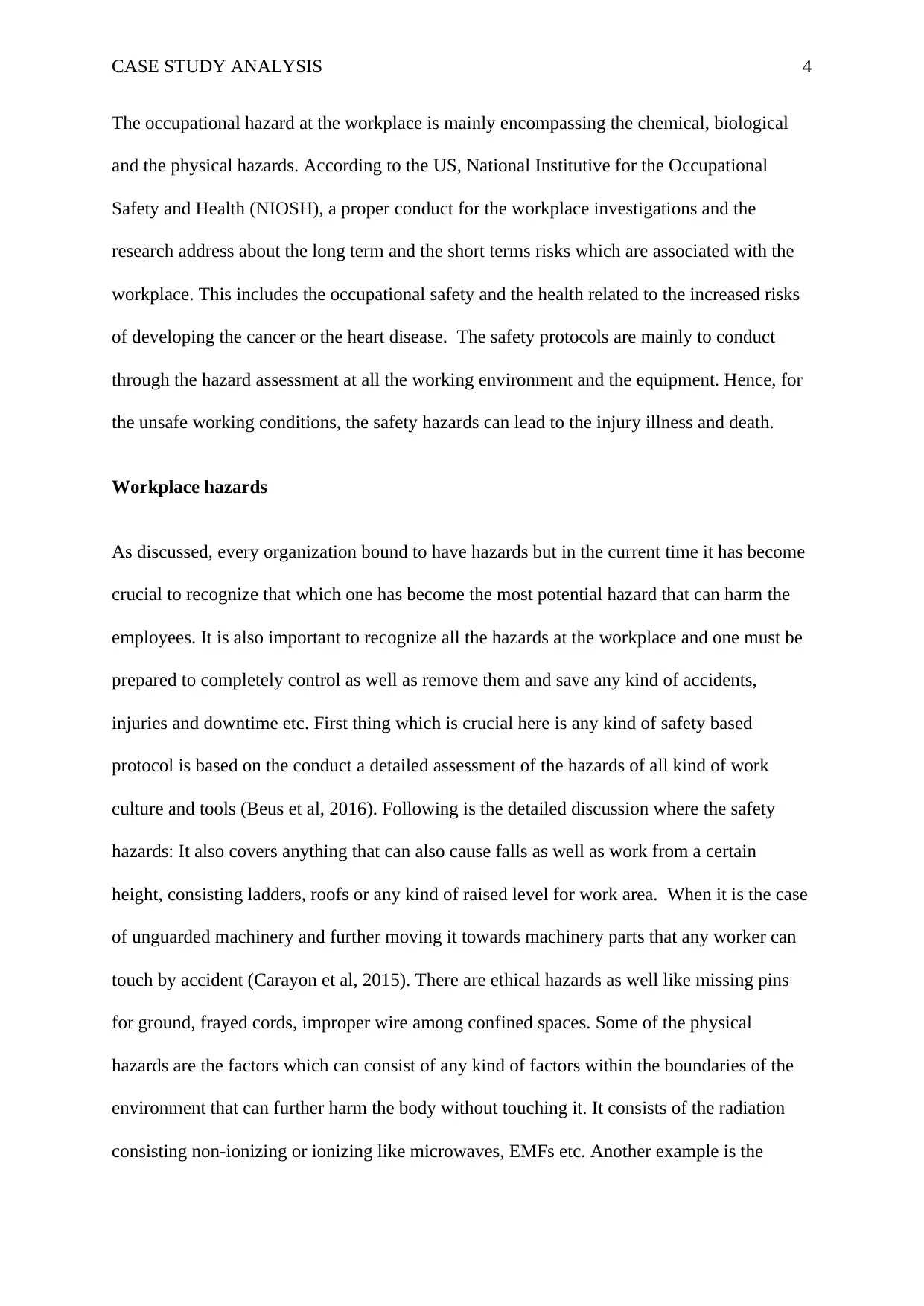
CASE STUDY ANALYSIS 4
The occupational hazard at the workplace is mainly encompassing the chemical, biological
and the physical hazards. According to the US, National Institutive for the Occupational
Safety and Health (NIOSH), a proper conduct for the workplace investigations and the
research address about the long term and the short terms risks which are associated with the
workplace. This includes the occupational safety and the health related to the increased risks
of developing the cancer or the heart disease. The safety protocols are mainly to conduct
through the hazard assessment at all the working environment and the equipment. Hence, for
the unsafe working conditions, the safety hazards can lead to the injury illness and death.
Workplace hazards
As discussed, every organization bound to have hazards but in the current time it has become
crucial to recognize that which one has become the most potential hazard that can harm the
employees. It is also important to recognize all the hazards at the workplace and one must be
prepared to completely control as well as remove them and save any kind of accidents,
injuries and downtime etc. First thing which is crucial here is any kind of safety based
protocol is based on the conduct a detailed assessment of the hazards of all kind of work
culture and tools (Beus et al, 2016). Following is the detailed discussion where the safety
hazards: It also covers anything that can also cause falls as well as work from a certain
height, consisting ladders, roofs or any kind of raised level for work area. When it is the case
of unguarded machinery and further moving it towards machinery parts that any worker can
touch by accident (Carayon et al, 2015). There are ethical hazards as well like missing pins
for ground, frayed cords, improper wire among confined spaces. Some of the physical
hazards are the factors which can consist of any kind of factors within the boundaries of the
environment that can further harm the body without touching it. It consists of the radiation
consisting non-ionizing or ionizing like microwaves, EMFs etc. Another example is the
The occupational hazard at the workplace is mainly encompassing the chemical, biological
and the physical hazards. According to the US, National Institutive for the Occupational
Safety and Health (NIOSH), a proper conduct for the workplace investigations and the
research address about the long term and the short terms risks which are associated with the
workplace. This includes the occupational safety and the health related to the increased risks
of developing the cancer or the heart disease. The safety protocols are mainly to conduct
through the hazard assessment at all the working environment and the equipment. Hence, for
the unsafe working conditions, the safety hazards can lead to the injury illness and death.
Workplace hazards
As discussed, every organization bound to have hazards but in the current time it has become
crucial to recognize that which one has become the most potential hazard that can harm the
employees. It is also important to recognize all the hazards at the workplace and one must be
prepared to completely control as well as remove them and save any kind of accidents,
injuries and downtime etc. First thing which is crucial here is any kind of safety based
protocol is based on the conduct a detailed assessment of the hazards of all kind of work
culture and tools (Beus et al, 2016). Following is the detailed discussion where the safety
hazards: It also covers anything that can also cause falls as well as work from a certain
height, consisting ladders, roofs or any kind of raised level for work area. When it is the case
of unguarded machinery and further moving it towards machinery parts that any worker can
touch by accident (Carayon et al, 2015). There are ethical hazards as well like missing pins
for ground, frayed cords, improper wire among confined spaces. Some of the physical
hazards are the factors which can consist of any kind of factors within the boundaries of the
environment that can further harm the body without touching it. It consists of the radiation
consisting non-ionizing or ionizing like microwaves, EMFs etc. Another example is the
Paraphrase This Document
Need a fresh take? Get an instant paraphrase of this document with our AI Paraphraser
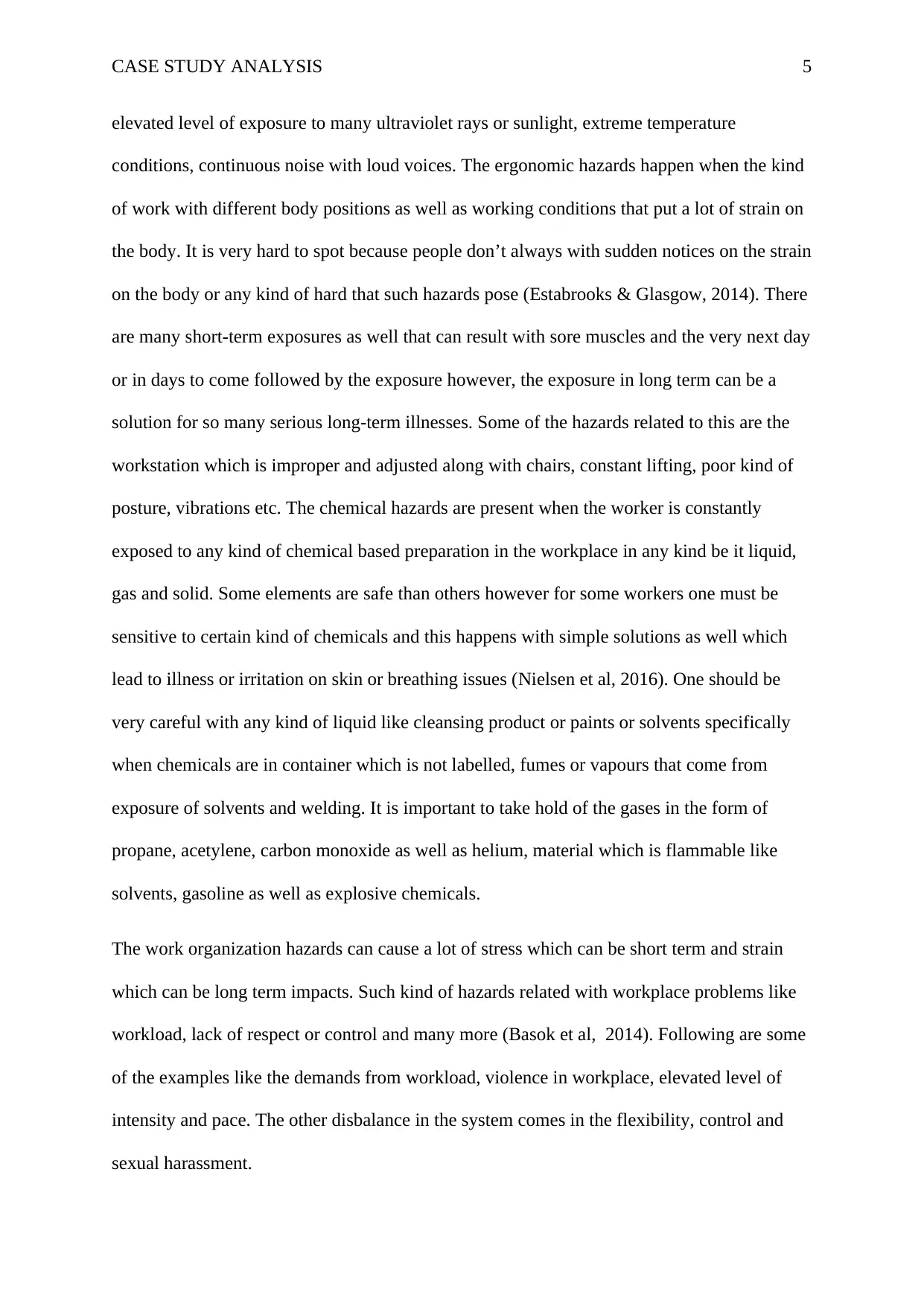
CASE STUDY ANALYSIS 5
elevated level of exposure to many ultraviolet rays or sunlight, extreme temperature
conditions, continuous noise with loud voices. The ergonomic hazards happen when the kind
of work with different body positions as well as working conditions that put a lot of strain on
the body. It is very hard to spot because people don’t always with sudden notices on the strain
on the body or any kind of hard that such hazards pose (Estabrooks & Glasgow, 2014). There
are many short-term exposures as well that can result with sore muscles and the very next day
or in days to come followed by the exposure however, the exposure in long term can be a
solution for so many serious long-term illnesses. Some of the hazards related to this are the
workstation which is improper and adjusted along with chairs, constant lifting, poor kind of
posture, vibrations etc. The chemical hazards are present when the worker is constantly
exposed to any kind of chemical based preparation in the workplace in any kind be it liquid,
gas and solid. Some elements are safe than others however for some workers one must be
sensitive to certain kind of chemicals and this happens with simple solutions as well which
lead to illness or irritation on skin or breathing issues (Nielsen et al, 2016). One should be
very careful with any kind of liquid like cleansing product or paints or solvents specifically
when chemicals are in container which is not labelled, fumes or vapours that come from
exposure of solvents and welding. It is important to take hold of the gases in the form of
propane, acetylene, carbon monoxide as well as helium, material which is flammable like
solvents, gasoline as well as explosive chemicals.
The work organization hazards can cause a lot of stress which can be short term and strain
which can be long term impacts. Such kind of hazards related with workplace problems like
workload, lack of respect or control and many more (Basok et al, 2014). Following are some
of the examples like the demands from workload, violence in workplace, elevated level of
intensity and pace. The other disbalance in the system comes in the flexibility, control and
sexual harassment.
elevated level of exposure to many ultraviolet rays or sunlight, extreme temperature
conditions, continuous noise with loud voices. The ergonomic hazards happen when the kind
of work with different body positions as well as working conditions that put a lot of strain on
the body. It is very hard to spot because people don’t always with sudden notices on the strain
on the body or any kind of hard that such hazards pose (Estabrooks & Glasgow, 2014). There
are many short-term exposures as well that can result with sore muscles and the very next day
or in days to come followed by the exposure however, the exposure in long term can be a
solution for so many serious long-term illnesses. Some of the hazards related to this are the
workstation which is improper and adjusted along with chairs, constant lifting, poor kind of
posture, vibrations etc. The chemical hazards are present when the worker is constantly
exposed to any kind of chemical based preparation in the workplace in any kind be it liquid,
gas and solid. Some elements are safe than others however for some workers one must be
sensitive to certain kind of chemicals and this happens with simple solutions as well which
lead to illness or irritation on skin or breathing issues (Nielsen et al, 2016). One should be
very careful with any kind of liquid like cleansing product or paints or solvents specifically
when chemicals are in container which is not labelled, fumes or vapours that come from
exposure of solvents and welding. It is important to take hold of the gases in the form of
propane, acetylene, carbon monoxide as well as helium, material which is flammable like
solvents, gasoline as well as explosive chemicals.
The work organization hazards can cause a lot of stress which can be short term and strain
which can be long term impacts. Such kind of hazards related with workplace problems like
workload, lack of respect or control and many more (Basok et al, 2014). Following are some
of the examples like the demands from workload, violence in workplace, elevated level of
intensity and pace. The other disbalance in the system comes in the flexibility, control and
sexual harassment.
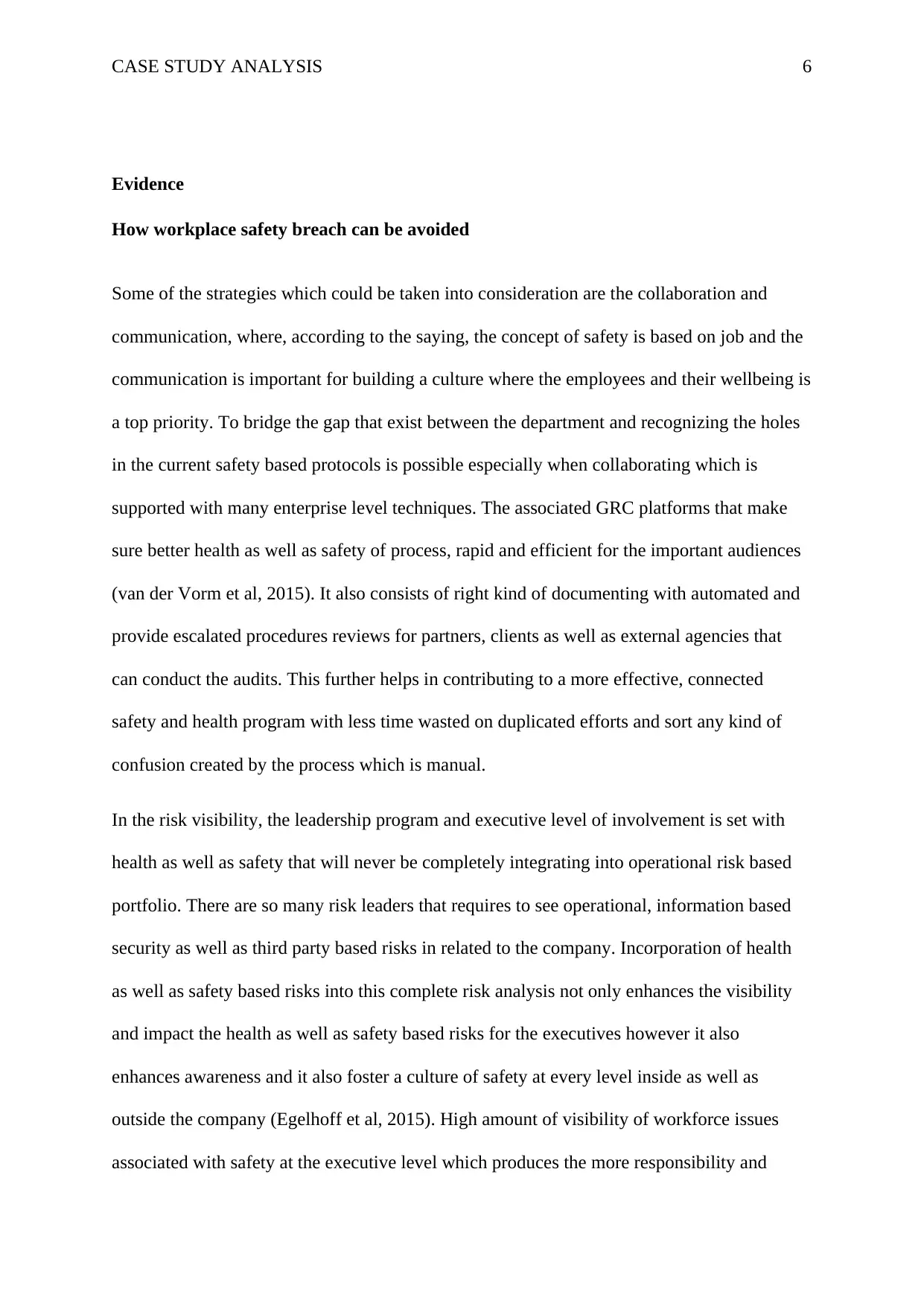
CASE STUDY ANALYSIS 6
Evidence
How workplace safety breach can be avoided
Some of the strategies which could be taken into consideration are the collaboration and
communication, where, according to the saying, the concept of safety is based on job and the
communication is important for building a culture where the employees and their wellbeing is
a top priority. To bridge the gap that exist between the department and recognizing the holes
in the current safety based protocols is possible especially when collaborating which is
supported with many enterprise level techniques. The associated GRC platforms that make
sure better health as well as safety of process, rapid and efficient for the important audiences
(van der Vorm et al, 2015). It also consists of right kind of documenting with automated and
provide escalated procedures reviews for partners, clients as well as external agencies that
can conduct the audits. This further helps in contributing to a more effective, connected
safety and health program with less time wasted on duplicated efforts and sort any kind of
confusion created by the process which is manual.
In the risk visibility, the leadership program and executive level of involvement is set with
health as well as safety that will never be completely integrating into operational risk based
portfolio. There are so many risk leaders that requires to see operational, information based
security as well as third party based risks in related to the company. Incorporation of health
as well as safety based risks into this complete risk analysis not only enhances the visibility
and impact the health as well as safety based risks for the executives however it also
enhances awareness and it also foster a culture of safety at every level inside as well as
outside the company (Egelhoff et al, 2015). High amount of visibility of workforce issues
associated with safety at the executive level which produces the more responsibility and
Evidence
How workplace safety breach can be avoided
Some of the strategies which could be taken into consideration are the collaboration and
communication, where, according to the saying, the concept of safety is based on job and the
communication is important for building a culture where the employees and their wellbeing is
a top priority. To bridge the gap that exist between the department and recognizing the holes
in the current safety based protocols is possible especially when collaborating which is
supported with many enterprise level techniques. The associated GRC platforms that make
sure better health as well as safety of process, rapid and efficient for the important audiences
(van der Vorm et al, 2015). It also consists of right kind of documenting with automated and
provide escalated procedures reviews for partners, clients as well as external agencies that
can conduct the audits. This further helps in contributing to a more effective, connected
safety and health program with less time wasted on duplicated efforts and sort any kind of
confusion created by the process which is manual.
In the risk visibility, the leadership program and executive level of involvement is set with
health as well as safety that will never be completely integrating into operational risk based
portfolio. There are so many risk leaders that requires to see operational, information based
security as well as third party based risks in related to the company. Incorporation of health
as well as safety based risks into this complete risk analysis not only enhances the visibility
and impact the health as well as safety based risks for the executives however it also
enhances awareness and it also foster a culture of safety at every level inside as well as
outside the company (Egelhoff et al, 2015). High amount of visibility of workforce issues
associated with safety at the executive level which produces the more responsibility and
⊘ This is a preview!⊘
Do you want full access?
Subscribe today to unlock all pages.

Trusted by 1+ million students worldwide
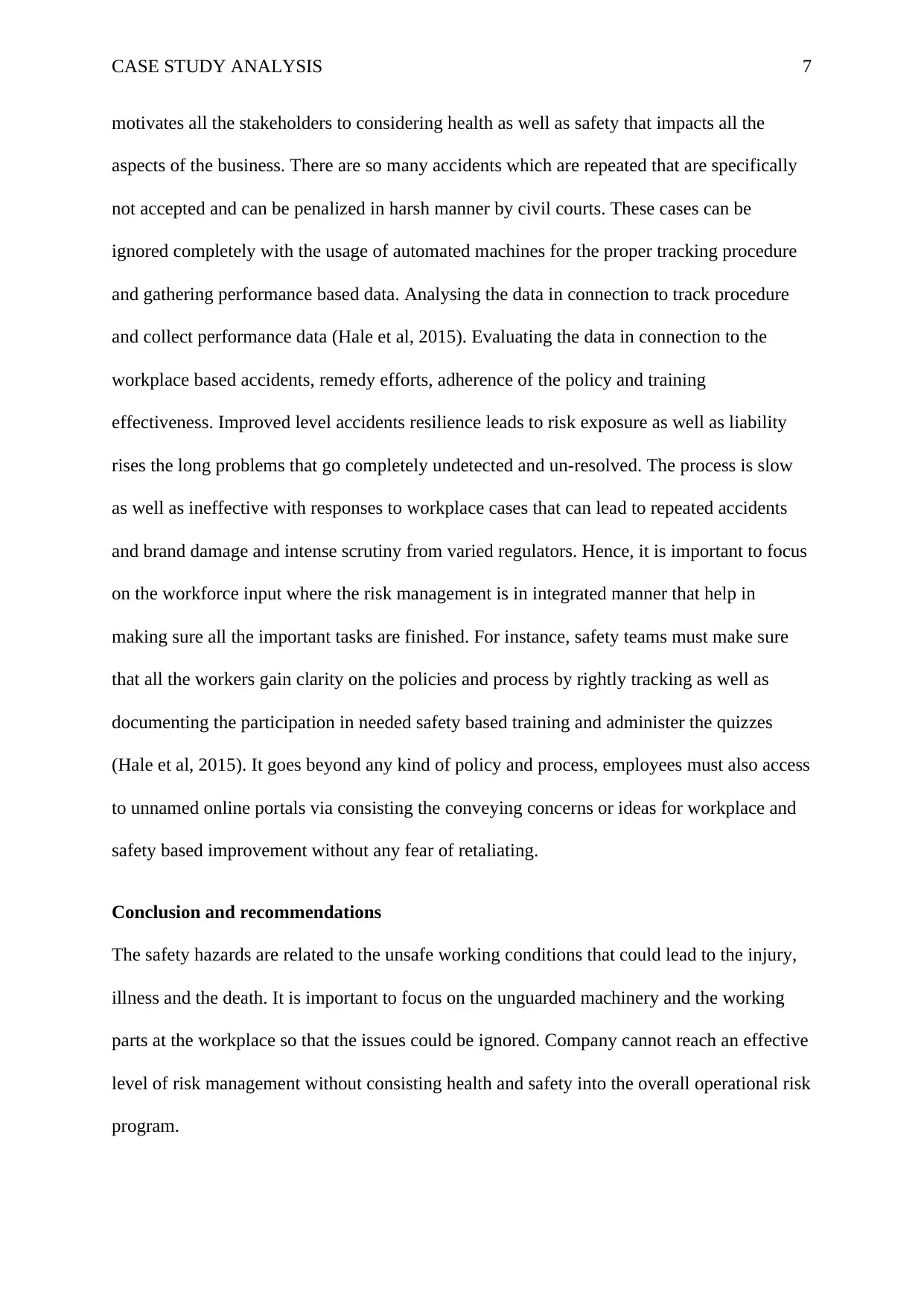
CASE STUDY ANALYSIS 7
motivates all the stakeholders to considering health as well as safety that impacts all the
aspects of the business. There are so many accidents which are repeated that are specifically
not accepted and can be penalized in harsh manner by civil courts. These cases can be
ignored completely with the usage of automated machines for the proper tracking procedure
and gathering performance based data. Analysing the data in connection to track procedure
and collect performance data (Hale et al, 2015). Evaluating the data in connection to the
workplace based accidents, remedy efforts, adherence of the policy and training
effectiveness. Improved level accidents resilience leads to risk exposure as well as liability
rises the long problems that go completely undetected and un-resolved. The process is slow
as well as ineffective with responses to workplace cases that can lead to repeated accidents
and brand damage and intense scrutiny from varied regulators. Hence, it is important to focus
on the workforce input where the risk management is in integrated manner that help in
making sure all the important tasks are finished. For instance, safety teams must make sure
that all the workers gain clarity on the policies and process by rightly tracking as well as
documenting the participation in needed safety based training and administer the quizzes
(Hale et al, 2015). It goes beyond any kind of policy and process, employees must also access
to unnamed online portals via consisting the conveying concerns or ideas for workplace and
safety based improvement without any fear of retaliating.
Conclusion and recommendations
The safety hazards are related to the unsafe working conditions that could lead to the injury,
illness and the death. It is important to focus on the unguarded machinery and the working
parts at the workplace so that the issues could be ignored. Company cannot reach an effective
level of risk management without consisting health and safety into the overall operational risk
program.
motivates all the stakeholders to considering health as well as safety that impacts all the
aspects of the business. There are so many accidents which are repeated that are specifically
not accepted and can be penalized in harsh manner by civil courts. These cases can be
ignored completely with the usage of automated machines for the proper tracking procedure
and gathering performance based data. Analysing the data in connection to track procedure
and collect performance data (Hale et al, 2015). Evaluating the data in connection to the
workplace based accidents, remedy efforts, adherence of the policy and training
effectiveness. Improved level accidents resilience leads to risk exposure as well as liability
rises the long problems that go completely undetected and un-resolved. The process is slow
as well as ineffective with responses to workplace cases that can lead to repeated accidents
and brand damage and intense scrutiny from varied regulators. Hence, it is important to focus
on the workforce input where the risk management is in integrated manner that help in
making sure all the important tasks are finished. For instance, safety teams must make sure
that all the workers gain clarity on the policies and process by rightly tracking as well as
documenting the participation in needed safety based training and administer the quizzes
(Hale et al, 2015). It goes beyond any kind of policy and process, employees must also access
to unnamed online portals via consisting the conveying concerns or ideas for workplace and
safety based improvement without any fear of retaliating.
Conclusion and recommendations
The safety hazards are related to the unsafe working conditions that could lead to the injury,
illness and the death. It is important to focus on the unguarded machinery and the working
parts at the workplace so that the issues could be ignored. Company cannot reach an effective
level of risk management without consisting health and safety into the overall operational risk
program.
Paraphrase This Document
Need a fresh take? Get an instant paraphrase of this document with our AI Paraphraser
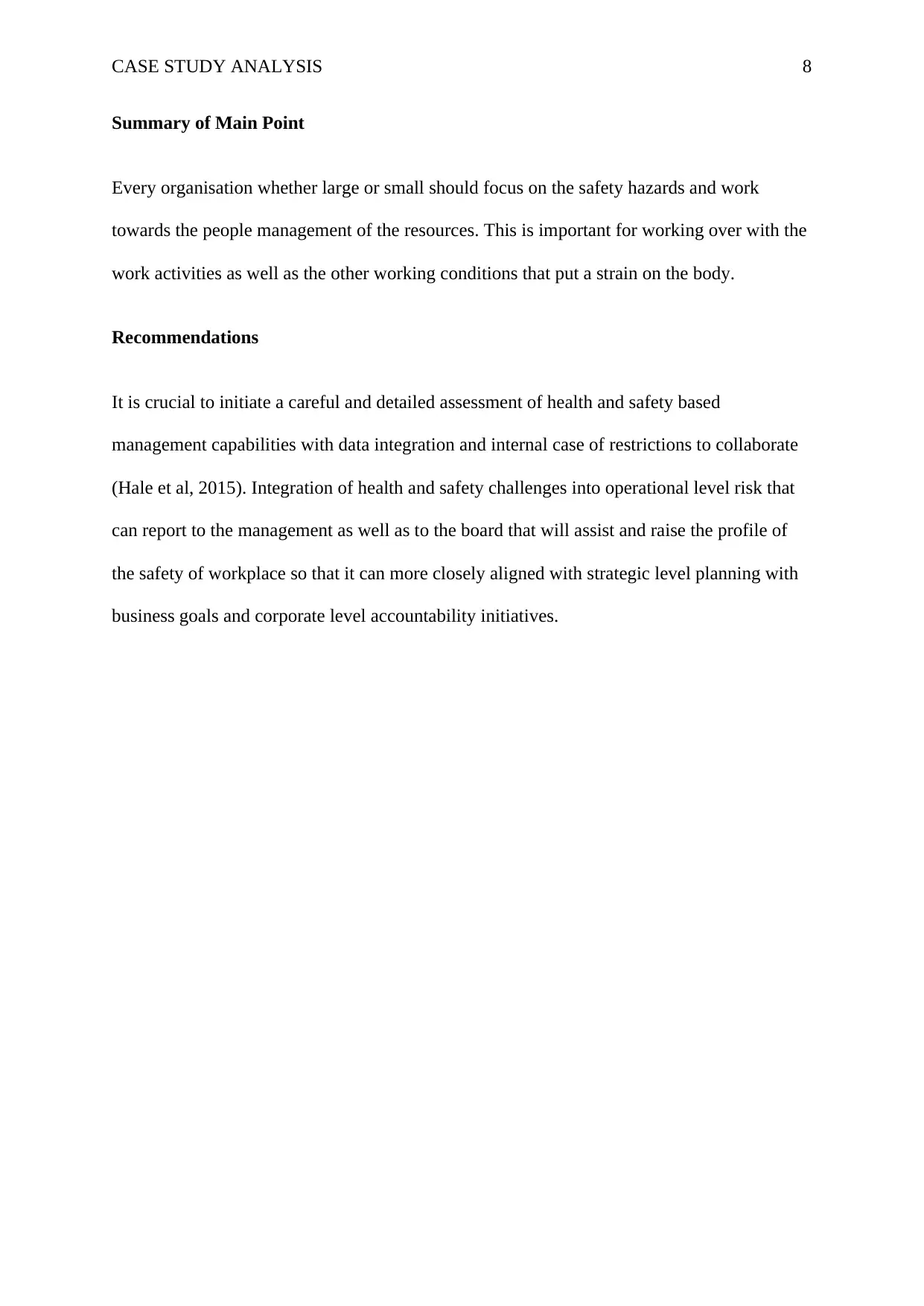
CASE STUDY ANALYSIS 8
Summary of Main Point
Every organisation whether large or small should focus on the safety hazards and work
towards the people management of the resources. This is important for working over with the
work activities as well as the other working conditions that put a strain on the body.
Recommendations
It is crucial to initiate a careful and detailed assessment of health and safety based
management capabilities with data integration and internal case of restrictions to collaborate
(Hale et al, 2015). Integration of health and safety challenges into operational level risk that
can report to the management as well as to the board that will assist and raise the profile of
the safety of workplace so that it can more closely aligned with strategic level planning with
business goals and corporate level accountability initiatives.
Summary of Main Point
Every organisation whether large or small should focus on the safety hazards and work
towards the people management of the resources. This is important for working over with the
work activities as well as the other working conditions that put a strain on the body.
Recommendations
It is crucial to initiate a careful and detailed assessment of health and safety based
management capabilities with data integration and internal case of restrictions to collaborate
(Hale et al, 2015). Integration of health and safety challenges into operational level risk that
can report to the management as well as to the board that will assist and raise the profile of
the safety of workplace so that it can more closely aligned with strategic level planning with
business goals and corporate level accountability initiatives.
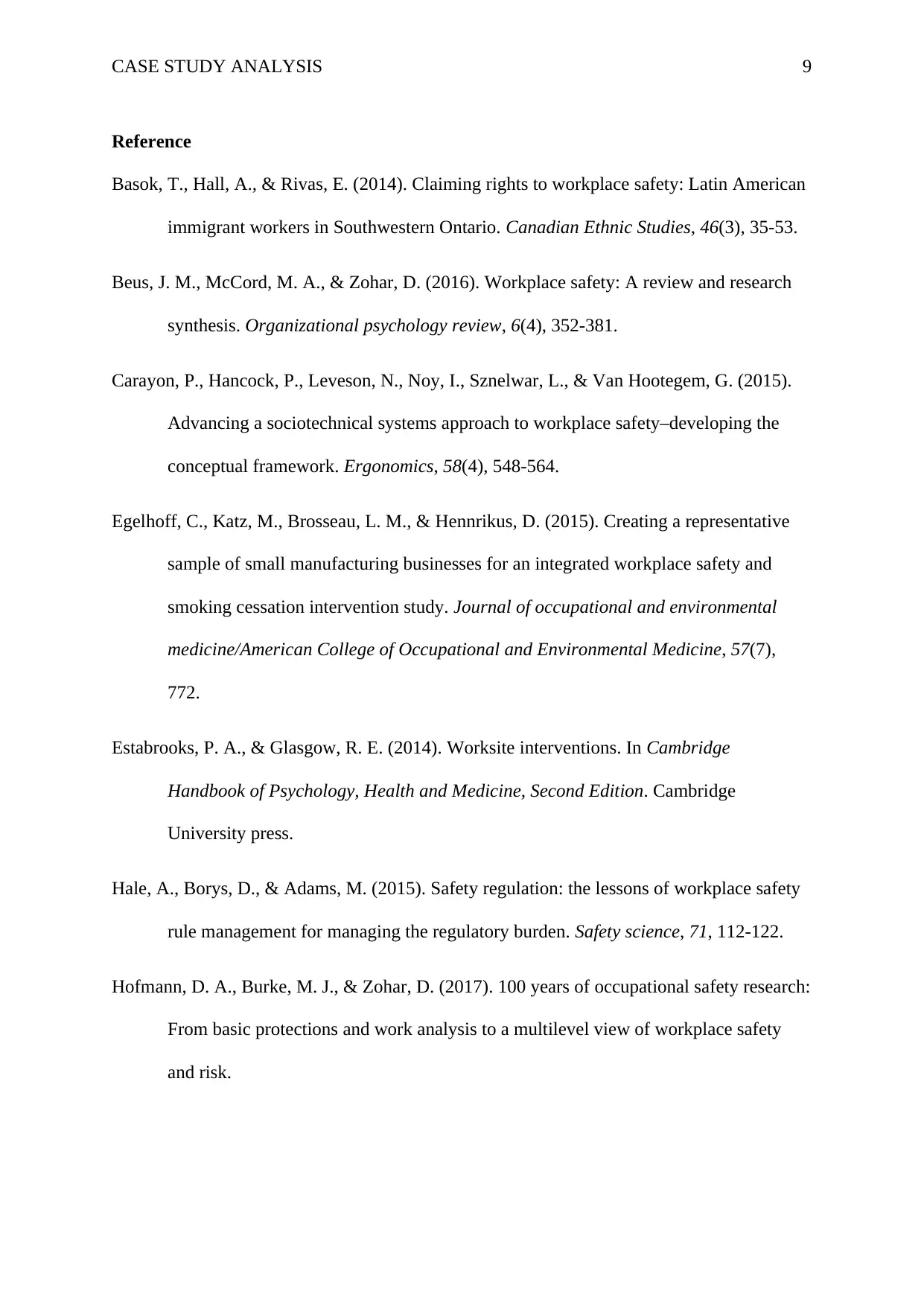
CASE STUDY ANALYSIS 9
Reference
Basok, T., Hall, A., & Rivas, E. (2014). Claiming rights to workplace safety: Latin American
immigrant workers in Southwestern Ontario. Canadian Ethnic Studies, 46(3), 35-53.
Beus, J. M., McCord, M. A., & Zohar, D. (2016). Workplace safety: A review and research
synthesis. Organizational psychology review, 6(4), 352-381.
Carayon, P., Hancock, P., Leveson, N., Noy, I., Sznelwar, L., & Van Hootegem, G. (2015).
Advancing a sociotechnical systems approach to workplace safety–developing the
conceptual framework. Ergonomics, 58(4), 548-564.
Egelhoff, C., Katz, M., Brosseau, L. M., & Hennrikus, D. (2015). Creating a representative
sample of small manufacturing businesses for an integrated workplace safety and
smoking cessation intervention study. Journal of occupational and environmental
medicine/American College of Occupational and Environmental Medicine, 57(7),
772.
Estabrooks, P. A., & Glasgow, R. E. (2014). Worksite interventions. In Cambridge
Handbook of Psychology, Health and Medicine, Second Edition. Cambridge
University press.
Hale, A., Borys, D., & Adams, M. (2015). Safety regulation: the lessons of workplace safety
rule management for managing the regulatory burden. Safety science, 71, 112-122.
Hofmann, D. A., Burke, M. J., & Zohar, D. (2017). 100 years of occupational safety research:
From basic protections and work analysis to a multilevel view of workplace safety
and risk.
Reference
Basok, T., Hall, A., & Rivas, E. (2014). Claiming rights to workplace safety: Latin American
immigrant workers in Southwestern Ontario. Canadian Ethnic Studies, 46(3), 35-53.
Beus, J. M., McCord, M. A., & Zohar, D. (2016). Workplace safety: A review and research
synthesis. Organizational psychology review, 6(4), 352-381.
Carayon, P., Hancock, P., Leveson, N., Noy, I., Sznelwar, L., & Van Hootegem, G. (2015).
Advancing a sociotechnical systems approach to workplace safety–developing the
conceptual framework. Ergonomics, 58(4), 548-564.
Egelhoff, C., Katz, M., Brosseau, L. M., & Hennrikus, D. (2015). Creating a representative
sample of small manufacturing businesses for an integrated workplace safety and
smoking cessation intervention study. Journal of occupational and environmental
medicine/American College of Occupational and Environmental Medicine, 57(7),
772.
Estabrooks, P. A., & Glasgow, R. E. (2014). Worksite interventions. In Cambridge
Handbook of Psychology, Health and Medicine, Second Edition. Cambridge
University press.
Hale, A., Borys, D., & Adams, M. (2015). Safety regulation: the lessons of workplace safety
rule management for managing the regulatory burden. Safety science, 71, 112-122.
Hofmann, D. A., Burke, M. J., & Zohar, D. (2017). 100 years of occupational safety research:
From basic protections and work analysis to a multilevel view of workplace safety
and risk.
⊘ This is a preview!⊘
Do you want full access?
Subscribe today to unlock all pages.

Trusted by 1+ million students worldwide
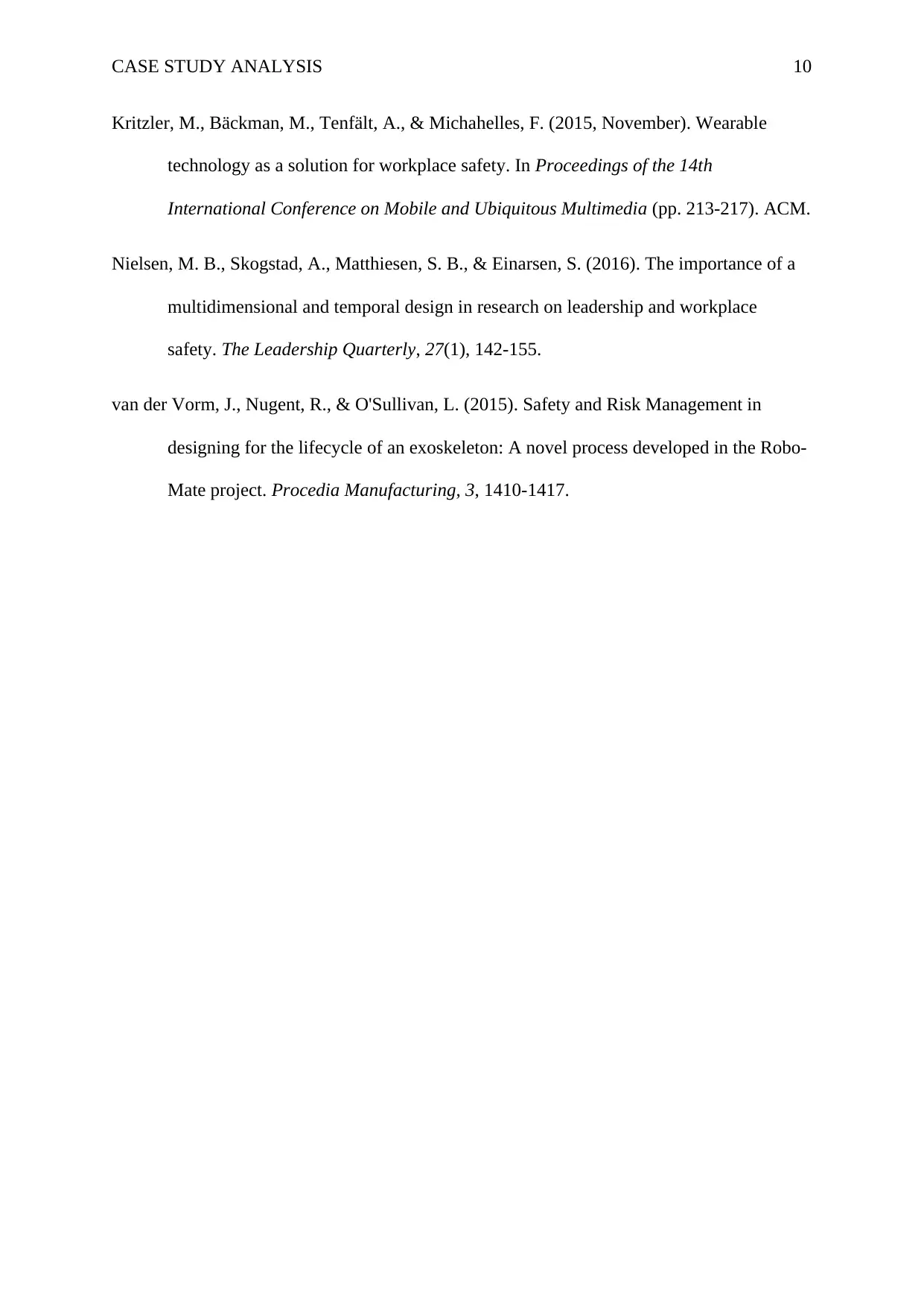
CASE STUDY ANALYSIS 10
Kritzler, M., Bäckman, M., Tenfält, A., & Michahelles, F. (2015, November). Wearable
technology as a solution for workplace safety. In Proceedings of the 14th
International Conference on Mobile and Ubiquitous Multimedia (pp. 213-217). ACM.
Nielsen, M. B., Skogstad, A., Matthiesen, S. B., & Einarsen, S. (2016). The importance of a
multidimensional and temporal design in research on leadership and workplace
safety. The Leadership Quarterly, 27(1), 142-155.
van der Vorm, J., Nugent, R., & O'Sullivan, L. (2015). Safety and Risk Management in
designing for the lifecycle of an exoskeleton: A novel process developed in the Robo-
Mate project. Procedia Manufacturing, 3, 1410-1417.
Kritzler, M., Bäckman, M., Tenfält, A., & Michahelles, F. (2015, November). Wearable
technology as a solution for workplace safety. In Proceedings of the 14th
International Conference on Mobile and Ubiquitous Multimedia (pp. 213-217). ACM.
Nielsen, M. B., Skogstad, A., Matthiesen, S. B., & Einarsen, S. (2016). The importance of a
multidimensional and temporal design in research on leadership and workplace
safety. The Leadership Quarterly, 27(1), 142-155.
van der Vorm, J., Nugent, R., & O'Sullivan, L. (2015). Safety and Risk Management in
designing for the lifecycle of an exoskeleton: A novel process developed in the Robo-
Mate project. Procedia Manufacturing, 3, 1410-1417.
1 out of 10
Related Documents
Your All-in-One AI-Powered Toolkit for Academic Success.
+13062052269
info@desklib.com
Available 24*7 on WhatsApp / Email
![[object Object]](/_next/static/media/star-bottom.7253800d.svg)
Unlock your academic potential
Copyright © 2020–2025 A2Z Services. All Rights Reserved. Developed and managed by ZUCOL.





